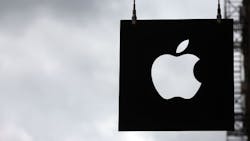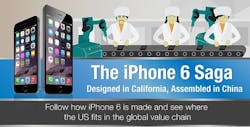Risky Business: Life and Death in Apple's Supply Chain
This was supposed to have been a big year for GT Advanced Technologies.
Last November, Apple (IW 500/4) plucked the solar panel maker out of obscurity, loaded it with a $587 million contract and set it to work building, stocking and operating a gigantic sapphire fabrication plant in Mesa, Ariz.
Though neither Apple nor GT ever said exactly what the sapphire would be used for, all signs pointed to the iPhone. The timing was right, the user interest was there. It was perfect.
The deal was hyped to create some 2,000 new jobs in the region and bump GT's overall revenue to somewhere around $700 million in 2014 -- 80% of which was to come from the sapphire project alone.
From just about every angle, it looked like the birth of a brand new American success story -- a domestic company finally profiting from Apple's notoriously complicated (and troublesome) supply chain.
By Sept. 8, 2014, GT stock was trading at an all-time high and the market cap had climbed to $2 billion.
Pavel Molchanov, energy analyst at Raymond James
But when Apple unveiled the new phones the next day, they had the same old glass screens as the last model. The only mention of sapphire anywhere in the release event was for the face of the Apple Watch, due out next year, and a tiny bit on the home button just as it was used in the previous release.
And that was pretty much it for GT.
Just six weeks later, the company filed Chapter 11 bankruptcy as the stock crashed from $18 to mere cents.
Apple's Latest Victim
The story of GT is a dramatic one, and one that caught everybody on the market -- including Apple, apparently -- by surprise. But it's not a new story. Nor is it entirely rare.
Across Apple's global supply chain, hundreds of companies live and die by their contracts. They are tied into ultra-secret, demanding supplier deals that offer low margins but the promise of high volume. Every company in that web takes a gamble on success, accepting the risk that every new Apple release, modification or quarterly report could earn them fortunes or wipe them out entirely.
"Apple, by virtue of being the biggest tech company in the world, is obviously not easy to work with for suppliers, just by definition," explains Pavel Molchanov, an energy analyst at Raymond James that has been covering GT since its early solar days
"That's not to say that companies cannot be successful in selling to Apple," he notes. "In fact, plenty of companies are successful selling to Apple, and GT could have been too, in theory."
This, he says, is just the inherent risk of dealing with Apple.
When a company falls in bed with Apple, the market tends to look at the bright side of the deal, Molchanov says. They look forward to the jobs it will bring, the revenues and innovations, all the proceeds of potential success.
But that ignores the downside.
The Sharp Story
In 2012, the same GT story almost played out at Sharp (IW 1000/160).
Sharp provided the displays for the iPhone 5, and, by multiple reports, had been propped up by a couple of billion-dollar loans from Apple just to deliver on the deal. If it had worked out, it could have brought Sharp back to its former glory.
But as authors Naoyoshi Goto and Jun Morikawa recall in their book "The Real Apple Empire," the phone was met with only mild excitement. People bought it, but the numbers were pretty disappointing across the board.
Those soft numbers sent Sharp spiraling quickly toward bankruptcy. If not for a $111 million save from Samsung (IW 1000/14), of all sources, it could have been the end.
Likewise, if the iPhone 6 and iPhone 6s had included GT's sapphire, the story could have played out at Corning, which provides the Gorilla Glass for the current displays.
"It's just not easy for Apple suppliers," Molchanov says. "Apple likes to have stringent terms and conditions for its suppliers." If those suppliers can't meet those conditions, Apple doesn't have to work very hard to find another that can, even if that means devastation for the original company.
Lessons Learned
The details of the GT implosion might never come out. The whole partnership, even the bankruptcy proceedings, are locked behind Apple's impenetrable confidentiality agreements.
But, Molchanov argues, "In the grand scheme of things, it doesn't really matter. It would be fascinating as a Harvard business school case study, if nothing else, on how a company goes from a $2 billion market cap with a stock at an all-time high to bankruptcy in six weeks. But really, this is just a lesson in understanding the risks."
In GT's case, 80% of its 2014 budget was to come from sapphire. That's what the market bought into, and that's where the energy of the company was focused. But putting that much weight on one deal was a precarious move, to say the least. When it fell, there was nothing left to hold the remainder up.
A company the size of Apple holds a tremendous amount of weight throughout the market. Every move it makes, every change it makes to its devices, can make and break suppliers across the world.
If you're getting in with Apple, that's part of the ride. GT is just its latest victim.
About the Author
Travis M. Hessman
Editor-in-Chief
Travis Hessman is the editor-in-chief and senior content director for IndustryWeek and New Equipment Digest. He began his career as an intern at IndustryWeek in 2001 and later served as IW's technology and innovation editor. Today, he combines his experience as an educator, a writer, and a journalist to help address some of the most significant challenges in the manufacturing industry, with a particular focus on leadership, training, and the technologies of smart manufacturing.

